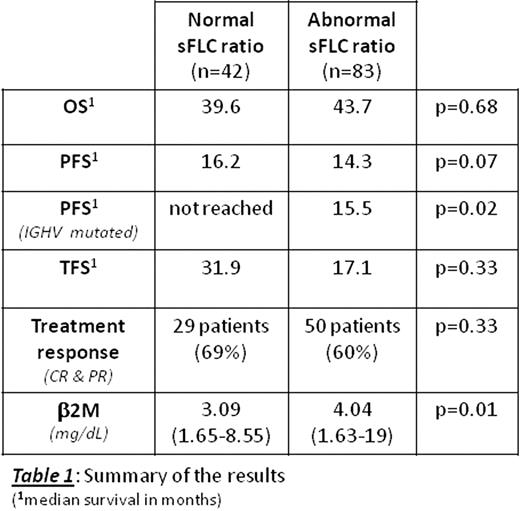Abstract
Abstract 2631
Poster Board II-607
The measurement of immunoglobulin serum free light chains (sFLC) has prognostic value in the spectrum of plasma cell dyscrasias and has been evaluated in other B-cell malignancies. Its utility as a biomarker of potential prognostic value in B-CLL ( chronic lymphocytic leukemia ) was previously reported in a study of 259 patients in whom 39% had an abnormal sFLC ratio which was associated with a shorter time to first treatment and poor survival (Pratt et al. BJH. 2008). The objective of the present analysis was to identify if these findings are applicable to a previously untreated population of 125 patients accrued to NCIC CTG trial CL2 treated in a uniform manner and characterized for cytogenetic abnormalities, ZAP-70 expression and IgVH mutational staus.
Sera from 125 untreated patients, previously enrolled in a non-randomised, non-blinded, phase II study evaluating the efficacy of oral fludarabine (NCIC CTG CL2 trial), were analysed retrospectively. Median age was 61 yrs (range: 33–92) and 39% patients (49) were female. Rai staging system - Stage I: n=30, II: n=54, III: n=19, IV: n=22. Kaplan-Meier survival curves and log-rank test were used in summarizing and comparing survival distributions between sFLC ratio normal and abnormal groups, and COX regression analysis adjusting for prespecified baseline factors of ZAP-70, IGVH mutational status, sFLC and b2M were also performed to compare the two groups.
83/125 (66%) patients showed an abnormal sFLC ratio (<0.26 or >1.65). Table 1 summarises the results. b2M was the only baseline factor showing a statistically significant association with the sFLC ratio (p=0.01). A total of 33 patients died over the course of the study (21 had an abnormal sFLC ratio vs 12 with a normal sFLC ratio), including 20 deaths attributed to the disease and/or its treatment (13 with abnormal sFLC ratios vs 7 with normal sFLC ratios). No statistically significant difference was found, either for overall survival (OS) or for treatment free survival (TFS) between patients with normal and abnormal sFLC ratios. However, patients with abnormal sFLC ratios did show a borderline significantly worse progression free survival (PFS) (HR= 1.48, 95% C.I. 0.97 – 2.28, p = 0.07), even after adjustment for pre-specified baseline factors (HR = 1.48, 95% C.I. 0.94 -2.34, p = 0.09). Furthermore, in patients with mutated IGVH, those with with an abnormal sFLC ratio had a significantly shorter PFS (HR = 2.76, 95% V.I. 1.1 – 6.9, p=0.02). COX regression analysis for OS found that age (> 65yrs), gender (male), and stage (III or IV) were poor prognostic factors. sFLC ratios were not significantly associated with response rates (60% vs. 69%, p = 0.33)
1) In this study of patients with untreated CLL with an indication for therapy, the frequency of an abnormal sFLC ratio is higher than previously reported i.e. 66% vs 44% (Martin et al. Trans Res. 2007) and 39% (Pratt et al. BJH. 2009). 2) The relation between IgVH mutational status and sFLC ratio needs further investigation. 3) The role of sFLC ratio as a prognostic biomarker in CLL should be evaluated in prospective trials of therapy in CLL.
No relevant conflicts of interest to declare.
Author notes
Asterisk with author names denotes non-ASH members.


This feature is available to Subscribers Only
Sign In or Create an Account Close Modal